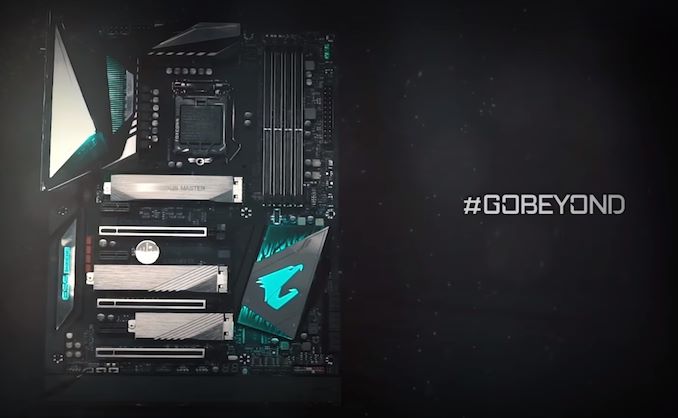Intel Z390 Motherboard Overview: 50+ Motherboards Analyzed
by Ian Cutress & Gavin Bonshor on October 8, 2018 10:53 AM EST- Posted in
- Motherboards
- Intel
- MSI
- Gigabyte
- ASRock
- EVGA
- Asus
- NZXT
- Supermicro
- Z390
GIGABYTE Z390 Aorus Xtreme
Although the existence of the Z390 Aorus Xtreme has been confirmed to me that it does in fact exist, it's not one of the motherboards that are going to be launched alongside the Z390 chipset on the 8th of October. This was announced on the AORUS official Facebook page through a video they released on September 29th and then highlighted again by VideoCardz. Now while the motherboard in the visuals isn't quite clear, it certainly isn't any other board that's already been documented in this overview from GIGABYTE.
 Link to Video on AORUS Official Facebook Page
Link to Video on AORUS Official Facebook Page
The most notable features on the board thought to be the new Z390 Aorus Xtreme are three full-length PCIe 3.0 slots which will most likely operate at x16, x8 and x4 respectively and the board also looks to include a trio of M.2 slots each with their own individual heatsink. The heatsinks are awash with RGB LEDs with lighting coming from both ends of the chipset heatsink, from the rear panel cover and from the audio PCB cover. On the bottom of the board the board, it looks to have dual BIOS (most Z390 GIGABYTE boards do) as two dip switches can be seen and also featured is an LED debug.
There's currently no information available including what's on the rear panel, the expected pricing, but we do know that the board is likely to be released either towards the end of October or in early November with the board's theme on being XTREME. It yet remains to be seen if GIGABYTE will be running a batch of extreme overclocking targeted motherboards or all their experience and chips have been placed into this particular model.
We will update this section once more details have been revealed.










79 Comments
View All Comments
Smell This - Tuesday, October 9, 2018 - link
Much.Of.
The.
Same.
2 HSIO lanes per Gen 2 port and WiFi. Wow (rolling I-eyeballs) ...
MadAd - Tuesday, October 9, 2018 - link
58 motherboards, only 13 of which are smaller than ATX. When on earth are we going to move off this outdated oversized format? Its just more of the same every time, so depressing.gavbon - Wednesday, October 10, 2018 - link
13 is better than 0, or 12 :DMadAd - Wednesday, October 10, 2018 - link
Considering very small form formats (ITX) are harder to build for and only 7 are uATX, a size which is the most useful to transition away from ATX then no, it feels like an afterthought from a lazy industry. I mean who uses more than 1 main video card and 2-4 sticks of ram in a gaming PC these days? Even water builds into uATX isnt that hard to accomplish.After literally decades ATX should be a choice for edge cases not a mainstream build.
shaolin95 - Monday, October 22, 2018 - link
who cares about midge boards!Edkiefer - Wednesday, October 10, 2018 - link
All these MB with 2x 8 pin power inputs, is both mandatory and if so I guess new PSU will need 2x 8pin now.entity279 - Wednesday, October 10, 2018 - link
so it's ok to just buy SM motherboards now with them being involved in a security scandal?gavbon - Thursday, October 11, 2018 - link
I currently have the Supermicro C9Z390-PGW awaiting to go on the test bench next week, so from a consumers standpoint, I could potentially shed light on that board. As far as the Chinese/Supermicro/Spy scandal goes, I don't want to speculate without the finer details.eastcoast_pete - Wednesday, October 10, 2018 - link
Ian & Gavin, thanks for the overview.@ both - Question: I've read that Intel, to deal with its bad planning/capacity problems on 14 nm, has contracted the fabbing of some of its chipsets out to TSMC, specifically in TSMC's 22 nm tech. Is that correct, and did you have a chance to confirm that the new 390s used by these boards are indeed made by Intel on their 14 nm FinFET tech, or are they made by a contractor (TSMC)?
DanNeely - Wednesday, October 10, 2018 - link
AFAIK the chipsets being reverted to 22nm are using Intel's 22nm process in old unupgraded fabs. Doing so would be far less work than porting to a process from a different company; the latter would require massive rework to follow a completely different set of design rules.